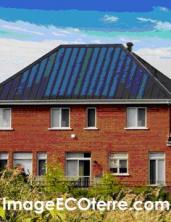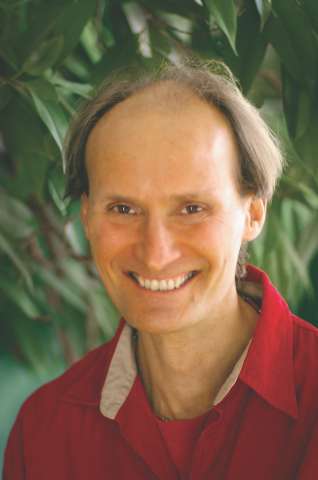 Voici comment Andreas Athienitis, professeur de genie du bâtiment à l’Université Concordia et directeur scientifique du Résesau canadien des bâtiments solaires, décrit sa propre maison solaire:
Voici comment Andreas Athienitis, professeur de genie du bâtiment à l’Université Concordia et directeur scientifique du Résesau canadien des bâtiments solaires, décrit sa propre maison solaire:
Our house was completed in 2006 and was also one of four finalists for the DOMUS award of APCHQ in that year (houses between $350,000 and $750,000). I designed its energy systems and passive systems. The passive solar design of this 272 m2 two-storey solar home in Brossard was optimized while taking into account its four occupants’ needs and priorities, as well as aesthetics. Its building-integrated photovoltaic thermal roof (BIPV) is currently unique. The house was designed to provide superior comfort, abundant daylight and to optimize solar energy utilization. It was custom designed by the owner in collaboration with the builder and his architect. It is expected that its annual energy consumption will be lower than that of an average Advanced House (less than about 45 kWh/square metre per year). Initial data of performance confirm this.
The major features of the house are the following:
1. Direct gain passive solar design that emphasizes utilization of distributed thermal mass in the south-facing part of the ground floor;
2. A grid-connected building-integrated photovoltaic-thermal system; this system generates up to about 2 kilowatts (kW) of electricity on a clear March day while producing about 4-6 kW of air or water heating.
3. The primary heating and cooling systems is a two-stage ground-source heat pump (2.2 ton) with an ECM (electronically commuted motor) fan;
4. A secondary floor heating system integrated in the floor mass of the direct gain zone;
5. A two-zone forced air system controlled by a multizone programmable thermostat which also controls the heat pump.
A major characteristic of the house is the attempt to optimize form – mainly the south façade, the aspect ratio and the solar roof. Its 40-degree sloped roof is optimal both for heat and electricity generation while shedding snow.
OPTIONAL:
HVAC and renewable energy systems
The key renewable generation system is a 1904 watt BIPV/T (building-integrated photovoltaic system with heat recovery) which can also typically produce 4 to 8 kW of heat at 200 litres/second of air flow. The PV array is composed of ten Unisolar amorphous silicon 136 W laminates plus eight 68 W laminates integrated on the standing seam metal roof. The size of the PV array was chosen to cover one complete surface for improved appeal while taking into account budget limitations.
Air is drawn from inlets in the plywood layer of the roof in the soffits and heated as it flows up in the cavity under the PV panels. Typically, the inlet air is hotter than the ambient temperature by about 5-10ºC due to being heated by the south-facing wall (except when windy). The flow velocity of the air under the PV will vary from a minimum of 0.5 m/s to a maximum of about 1 m/s and the outlet air temperature will typically be from 15°C to 30°C higher than the ambient air temperature. The cavity under the panels has vertical furring 1”x 3” for airflow between them and horizontal straps to attach the metal. The solar photovoltaic panels are thin rolls pasted on the metal before placing the metal on the roof. The wires of the PV panels enter the attic under the ridge panel at the top of the roof.
The key features of the energy system are the following:
• The 2.2 ton two-stage geothermal water-air heat pump (120 m deep borehole) with a 10 kW auxiliary electric heating coil (normally off, only used in very cold weather); it is connected to a two-zone air distribution system (HRV connected to the return) carefully designed to optimize distribution of passive solar gains when heating is not required and the ECM fan operates at low speed.
• Duct from BIPV/T roof that brings hot air to the mechanical room to heat water (or as fresh air).
• Two 272-litre water tanks connected in series; the low-temperature preheat tank water is heated through an air-water heat exchanger by the BIPV/T air and the heat pump desuperheater. It then enters the high temperature (60°C) DHW tank.
With the increasing availability of higher thermal R-values for glazings with high solar transmittance, it is necessary to have more mass to store the transmitted gains for elimination of daytime heating needs and possible reduction of nightime heating in winter. However the temperature must be allowed to swing 2-4 C in the space between day and night. Programmable thermostats with four setpoint periods allow this.
Widely accepted in Europe’s Passive House Program, this strategy is also implemented in the EcoTerra home (maisonalouette.com).
The Solar Building Research Network (SBRN) is developing design software that will be implemented in the HOT3000 software to optimize passive solar design.
My system is a prototype that I designed during my sabbatical leave.
I connected the wiring in the attic, saving some money.
Cost of PV system + inverter + wiring = $15,000
Cost of ducting etc for heat recovery from BIPV/T about $,5000.
Estimated payback for BIPV/T with heat recovery and full use: 10-15 years.
For heat pump: 5-10 years.
On the south side I have a metal roof which cost about $5,000 extra but will last 50 years.
Gound source heat pump and HVAC system plus two-zone controls: $29,000 (an equal size air source system would cost $24k - difference is the 400 ft borehole cost).
I plan to add more systems during my next sabbatical to come close to net-zero.
aathieni@encs.concordia.ca
www.solarbuildings.ca



